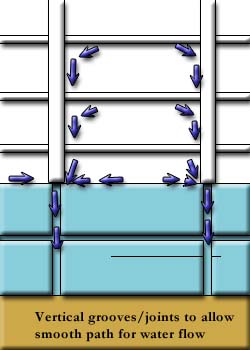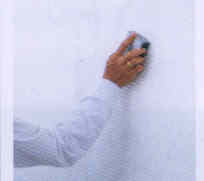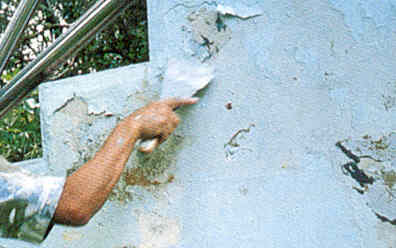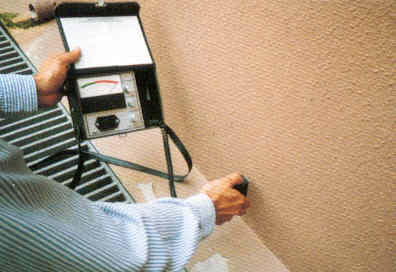Case 5
- Introduction
- Causes of Defects
- Good Practices
- Standards
- Maintenance and Diagnostics
- Remedial
- Similar Cases
- References
Good Practices
Façade design

The parapet wall can designed to slope towards the roof so that runoff laden with rust and dirt particles will not flow over the parapet and onto the wall surface, but instead to the roof.
Incorporate vertical joints channels on the parapet that aligns with the railings Figure 1.
Paint
Material
Use of a paint system, which allows moisture to pass through the coating to reduce the moisture pressure is another alternative to minimize paint defects caused by moisture [1-7].
Construction
Prior to the application or re-application of paint system, surface condition should be checked. Surface condition for painting process should be as follows[7-9]:
- For new plaster, the plaster surface should be allowed about 30 days for proper curing and the reduction of moisture content. Further, it will need to be primed. The type of primer used will depend upon the final decoration required. If you plan to use oil-based paint, an alkaline-resisting primer should be used. For water-based paints, a diluted first coat can be used to prime.
- For old surface, the preparation required will depend upon the condition of the surface. If it is clean, dry, and sound it will require no special preparation. However, if the surface is powdery or there is other evidence of old distemper residue, it should be dusted off and sealed with a stabilizing solution.
- For the painted surfaces, the existing paintwork should be washed down first. This is necessary to remove traces of dirt and grease, which would otherwise cause failure of subsequent decoration.



Light sanding with fine-grade, preferably part-worn, sandpaper would be able to remove ‘nibs’ and adherent dust particles, and to assist adhesion or provide a smooth level surface (Figure 2). Remove all loose and foreign particles by manual cleaning with scraping for painted surfaces (Figure 3).
Check the moisture of the substrate(Figure 4). The moisture content should not be more than 6%.
Quality Control
Quality assurance can be carried out as below:
| STAGES OF WORK | CHECK | CRITERIA |
| Recognition of environmental conditions | Temperature of site | Ambient temperature > 5 °C or refer to manufacturer’s recommendations |
| Substrate temperature | Surface temperature of substrate < 60 °C or refer to manufacturer’s recommendationsSurface temperature of substrate > 3 °C + ambient temperature or refer to manufacturer’s recommendations | |
| Relative humidity | Refer to manufacturer’s recommendations | |
| Checking of Surface Preparation | Method of surface preparation | Comply to approved submission |
| Prepared surface | Free from foreign and unstable matters such as dust, dirt, rust, cement, spatter, salt, grease and oil | |
| Mixing of paint | Mixing ratio | Comply to specificationSufficient stirring until uniformity |
| Painting control | Surface just before painting | Painting should start preferably within 24 hours after preparation |
| Protection to elements not to be coated | Mask or cover those elements not to be coated | |
| Process of application | Comply to approved submission | |
| Intervals between coats | Refer to manufacturer’s recommendations | |
| Wet film thickness | Refer to manufacturer’s recommendations |
Source: BCA (2001b) Good Industry Practice-Painting
Water repellent and surface coating system
Clear water repellents are most effective at reducing the amount of water absorbed by the brick masonry. Thus, they can help reduce staining and fungi growth caused by moisture absorption, particularly on highly absorptive masonry.
Surface preparation is important. The surface on which the coating is to be applied has to be:
- cleaned by grinding, chemical etching or blasting.
- dried by allowing the wall to cure for a few days before the coating is applied. During rainy periods, the walls should be protected with a plastic covering so that the drying is not interrupted.
Other surface protection systems include:
- Impregnation systems:
- Prevent penetration of water and solutions into brick without hindering the escape of internal moisture from concrete
- Materials used [3]:
- silicon organic solutions
- resins
- oils
- Sealers
- Heavy barrier against penetrating solutions but may hinder the escape of internal moisture
- Materials used [3]:
- epoxy resins (EP)
- polyurethane resins (PU)
- unsaturated polyester resins (UP)
- Coatings
- compared to sealers, they provide additional protection against mechanical influence.
- increased resistance to diffusion of internal moisture
- Materials used [3]:
- plastic modified cement systems and resins